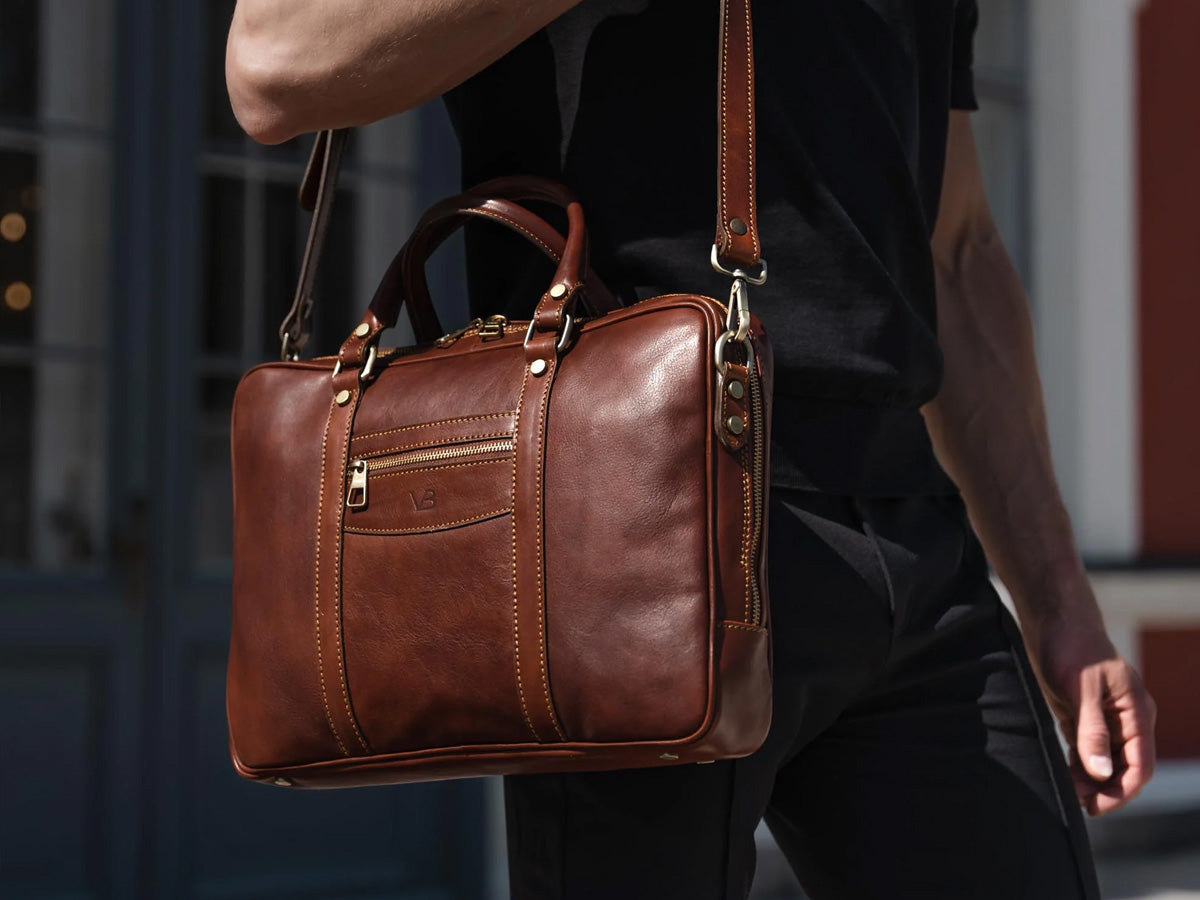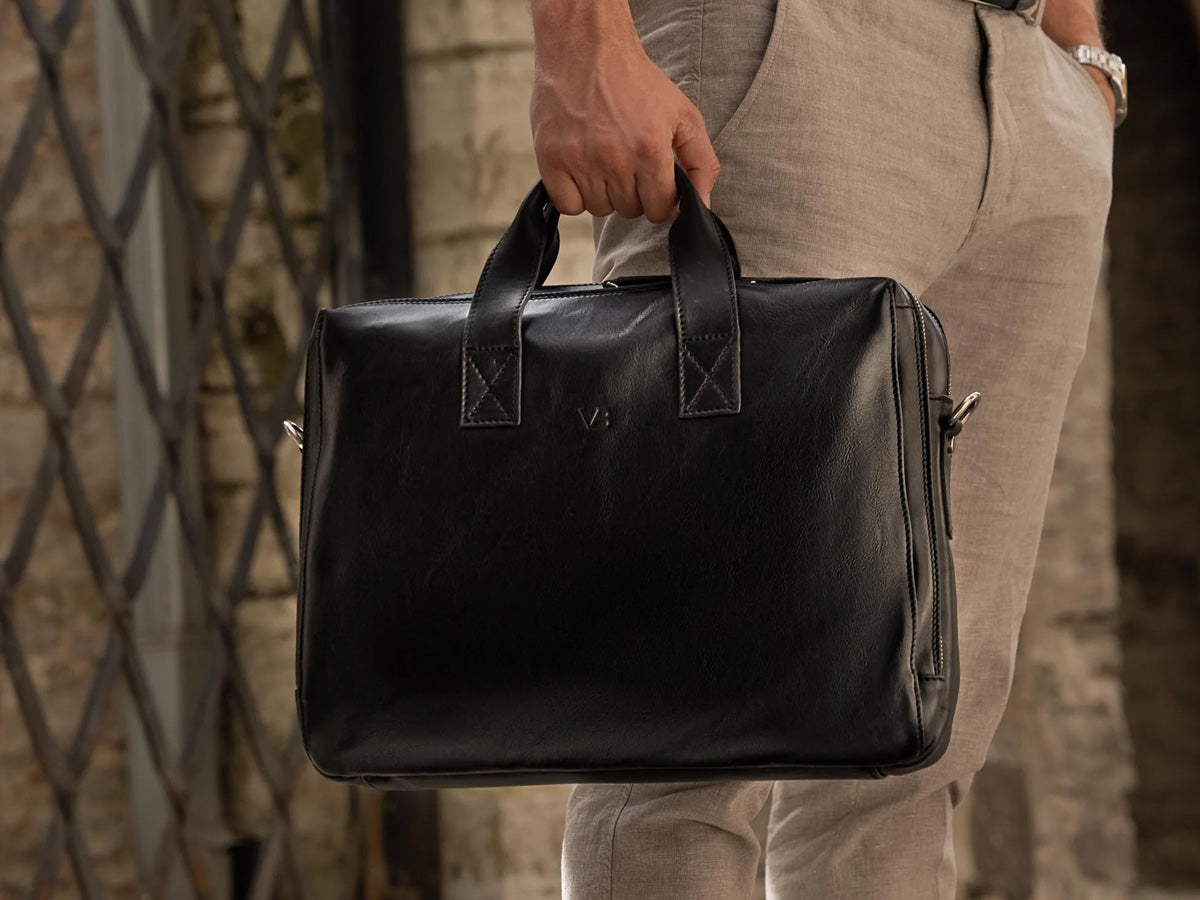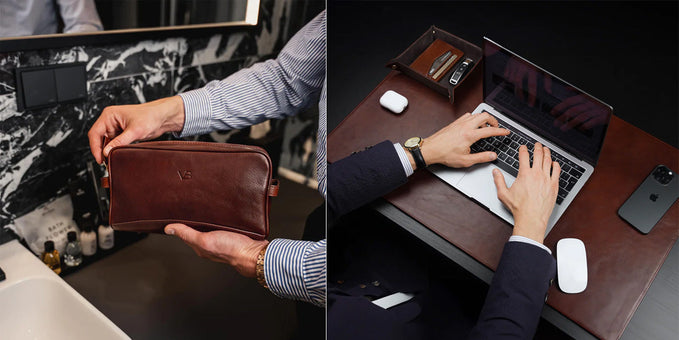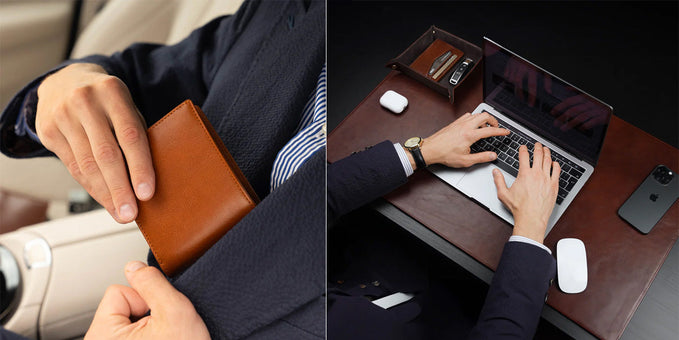Italian leather

Italian leather is synonymous with quality and luxurious tradition.
It is thought of as the top tier of leather goods in the world.
At Von Baer, we produce all of our leather bags using full grain Italian leather, to ensure it's the highest quality possible.
In this article, we discuss what Italian leather is, why it is so highly regarded, how to maintain it and more.
What is Italian leather?

Italian leather is simply leather produced in Italy.
Some of the best tanneries in the world are located in Italy, some of them specializing in one or another of the techniques or final products of the leather industry.
Vegetable tanning, for example, employs vegetable tannins extracted from tree bark, plants, and fruit, to process animal hides, producing a durable, beautiful, and highly prized construction material for clothing and accessories.
The leather that gives Italian leather its reputation, is premium, full grain leather. This is the top of the mountain for leathers.
City Italian Leather Laptop Bag from Von Baer
Produced from the topmost layer of the animal hide, this leather is thick, supple, hard-wearing, unique to each piece, and smells rich, natural, and pleasant.
It needs to be said, though, that there is nothing that says leather made in Italy is that same, high-quality product.
There is nothing stopping a company from elsewhere in the world, or a less proud Italian company, from producing inferior leather within the country.
This would still be Italian leather… but the product would not be on par with the best the country has on offer.
These cheaper products are marketed with the same “Italian Leather” claim, and it is technically true, but in spirit it is misleading and does not provide what it implies.
How do you tell if the product is of high-quality leather? We’ll touch on that a bit more, later in the article.
Essential Modern Briefcase in Italian Leather from Von Baer
Why is Italian leather so highly regarded?
Knowledge and techniques of tanning and crafting leather has been handed down from artisan to artisan for many generations.
Specific blends of tannins for processing leathers, for example, produce different tones and colors of leather, highlight or subdue grains and imperfections, and affect the texture of the finished products.
Watch our informative video on our Italian vegetable tanned leather below:
Master tanners can adjust and modify recipes and techniques to achieve desired outcomes, making them part scientist, part artist, and every bit the masters that their professional ancestors were… often even using the same recipes kept secret among the group for centuries.
No.1 Italian Leather Briefcase from Von Baer
Each stage of leather processing is very specialized, and so each stage had specialists who work to master it and control it for desired outcomes and uses of the finished products.
Vegetable tanning can last up to sixty days, and consists of different stages that each produce a part of the desires whole. Getting each of these stages correct, adds to the beauty, durability, and of course the value of the leather and leather goods that result from them.
Today’s masters of leather tanning do not rely entirely on the rich heritage and vast knowledge base handed down to them from their predecessors – they are, like those predecessors, innovative and creative, striving always to improve, refine, and control the process.
Eighty percent of tanning machinery is produced in Italy, suggesting that the Italian tanneries and related industries are operating at the cusp of the current technology. Not only are they keeping up with the technological advances, they are often in the vanguard.
Italian Leather Weekender from Von Baer
Italian legislation is also keeping pace changes in the industry. These laws and guidelines aim to ensure that Italian leather is processed to strict standards. If a company does not follow these rules, the company can be deregistered – in other words, they can be put out of business.
Much of this legislation is aimed at environmental safety and sustainability.
Read next: How to dress like an Italian
What does it mean: Full Grain?
Full grain leather is the strongest, most durable, and arguably the most beautiful type of leather. It is made from the top layer of the hide, which means that it has the unique imperfections and nuances of the particular hide from which it is made. Each one is unique.
And: Top Grain?
Top grain leather is made from a thinner layer of hide. It is softer and more flexible than full grain, but not as durable. Its surface has been sanded down and finish coats are often added. It is cheaper than full grain leather, and resists stains better, but it doesn’t look as natural.
How to Clean Italian leather?
Cleaning leather is easy and safe, but only if done correctly. Wipe the exterior surface with a soft cloth dipped in warm, soapy water and lightly wrung out to prevent dripping or pooling onto the leather.
Follow this immediately by wiping with a different, clean and dry cloth. Let the damp leather dry out naturally, without blowing heated air onto it or placing it in direct sunlight. This will prevent streaks, discoloration, or permanent water spots from marring the appearance of the surface.
Voyager Italian Leather Carry-on Bag from Von Baer
The characteristics of Italian leather
You can spot genuine, full grained, vegetable-tanned Italian leather using a few distinct characteristics. Not only are these easy to spot, but you probably already know what one or more of them are!
The first step is to smell the item. It should have a rich aroma that is earthy, woody, and reminds you of other genuine leather items you have smelled in the past.
Italian leather also tends to be a bit oily to the touch, compared with other leathers, due to finishing techniques more commonly used in Italian tanneries.
It should also feel supple and flexible, though new leather can be a bit stiff until it has been used a bit – depending on the finishing techniques and whether or not it has been designed for supple luxury, or hard-wearing durability.
It should appear unique on the surface, not too uniform of texture or color. Genuine, full grain leather retains the “flaws” of the source hide, and this is desirable. Older leather should have developed some patina, taking on subtle stains or fading over time.
No.2 Italian Leather Messenger Briefcase from Von Baer
Uses of Italian leather
Italian leather is most highlighted in the production of high-end, designer handbags. Houses like Prada, Bottega, Venetta, and Gucci, all use high-end Italian leather in their bags, and highlighted it as part of their marketing.
Bags aren’t the only use of Italian leather though. Shoes and boots, wallets, upholstery, saddles, hats, belts – and a host of other items – can be and are frequently made from this excellent leather material.
Items made with properly processed Italian leather hold up well to wet or windy weather, last a long time even with rough handling, and often look more interesting, and therefore better, once they have endured some of what life has to throw at them.
Related leather articles:
- Leather
- Faux leather
- Vegan leather
- Bonded leather
- Genuine leather
- Pleather
- Top grain leather
- What is artificial leather?
- What is full grain leather
- Where does leather come from
- Mushroom leather
- Napa leather
- Pebbled leather
How to Identify Italian Leather
Italian leather is best identified using eight steps. If an article passes all eight of these, you can be confident that you are looking at a high quality leather item.
If you aren’t sure about a few of them – or if it outright fails in some area – then be suspicious, you’re probably looking at something less than the quality you were hoping for.
1. Examine the surface of the leather
When it comes to genuine leather, imperfections are a key mark of high quality. Look for imperfections, discolorations, wrinkles, and markings on the leather. These may be tiny, or they may be bolder – but they should be there.
If there is more than one item there to consider, look over two of them – they should not be exactly alike when it comes to the leather. Each genuine, full grain leather item should be unique.
These marking aren’t damage, they are evidence that the leather used was of high quality, and from a real animal – rather than a plastic-derived fake, or inferior leather source.
2. Smell the leather
Fake leather smells like plastic, or like nothing at all, but genuine leather has an earthy, woody smell.
If you aren’t sure what that smell is like, step into a store that sells western boots or saddles – or even breathe in the smell of some high quality, chunky belts in the menswear section.
3. Check the stitching holes and seams
Genuine leather is tough to sew, and the stitching holes often show the evidence of this toughness.
The holes may be slightly uneven, evidence of the pressure needed to punch through the thick leather. Fake leather, by comparison, is easily punctured, and much thinner, so the sewing machines produces much more uniform and neat holes.
If you have access to the end of the leather sheets, at a seam, perhaps, take a look there too. There should be only one, relatively thick layer, not a layer of leather-looking stuff glued to a paper later underneath it.
4. Press down on the surface of the leather
When you press down on genuine leather, a wrinkle pattern should appear. It will fade away quickly when you relieve the pressure.
Fake leather won’t do this. Fake leather often feels like vinyl or plastic, but it doesn’t always. Some fakes are very well done, and can pass a few of the tests we’ve listed for them… but they won’t pass all of them, and probably not even most of them.
5. Test the leather with a drop of water if you can
If you can, add a drop of water to a part of the leather that won’t be seen much, like the corner of the underside of a handbag.
If, after a few minutes, the water has not been absorbed, then the bag is likely fake leather. Genuine leather should absorb the moisture.
6. Check for a certificate of authenticity
If the item is in a reputable retain store, then you can also check for a certificate of authenticity.
There should be a tag on it that reads something like “100% Italian Leather” or “Certified Italian Leather.”
Quality manufacturers will include a tag like this, but if you are looking at a used item, it is possible that the tag was removed or damaged and lost during use.
If you are browsing handbags in a Gucci outlet, you’re pretty safe, but the more “mom and pop” the store looks, the more you’ll want to check for yourself, to ensure high quality. You can check out the manufacturer by looking online to see if they are legitimate.
You should find a website of some kind and, ideally, reviews (a mixture of good and bad, but, ideally, mostly good).
7. Be wary of suspiciously-low prices
Is a great deal? A really great deal? A once-in-a-lifetime-never-before-seen-for-a-product-like-this great deal?
Then beware.
High quality goods demand higher prices because they are worth it. Claims of top-quality materials and manufacture, coupled with bargain basement prices, are a definite red flag.
Italian handbags should go from around $500, to many thousands, depending on brand name and how recent or in-demand the design is.
These things can turn up in thrift stores from time to time, and in that case the seller may have it marked at incredibly low prices. That’s okay, consider yourself very lucky. But if it is that low price and on sale as a new item, in a retail shop… it’s likely not kosher.
Genuine Italian, full grain leather items are not always from famous brands, either. You can get some great items from manufacturers that simply aren’t famous (yet?).
Follow the guidelines for stopping high quality products, and you should be fine.
8. Ask about the warranty
Most Italian leather products, of higher quality especially, come with a warranty. Not all products come with warranties, but the lack of one might be a sign that the store or manufacturer knows that the quality of the product isn’t likely to stand up to regular use.
Let that be a sign to you as well… might be best to look elsewhere.
Related leather posts:
- Leather guide for beginners
- What is leather patina
- Vegetable tanned leather
- Leather tanning
- Where does leather come from
- Leather grades
- How is leather made
History of Italian leather
Leather tanning, as an Italian industry, has been going strong as far back as the 8th century BCE. The Etruscans, inhabitants of part of today’s Italy, developed vegetable tanning, and the techniques they used remain largely unchanged today! Shoemakers, striving for durability and reasonable comfort, drove the advancements forward.
Under the Roman Empire, leather production grew in importance as clothing, transportation equipment components, and weaponry components. The Romans regulated the industry, and dedicated leather tanneries popped up to serve the needs of the expanding armies and empire. There is even evidence of a thriving tannery in the ruins of Pompeii, destroyed by volcanic eruption in 79CE.
In 1282, the leather worker’s guild was established. This Arte dei Cuoai, was one of many such guilds in Florence, and its purpose was to protect the trade secrets of the industry, and to enforce standards of quality. Artisan leather producers and craftspeople still thrive along the banks of the River Arno, from Florence to Pisa.
Some of today’s leading fashion houses began near the onset of the 20th century. Names like Prada (1913), Gucci (1921) and Ferragamo (1927) opened their doors and began to build the brand names we recognize today – much of it using premium, Italian full grain leather as a mark of quality. Their success, in turn, bolstered the reputation of, and demand for, genuine Italian leather, worldwide.
Today, the Genuine Italian Vegetable-Tanned Leather Consortium plays a vital role in protecting the reputation and quality standards of Italian leather and leather goods.
Based in Tuscany, this group of twenty tanneries value time-honored standards and techniques, promote a high level of craftsmanship, and continue to produce some of the best leathers the world has to offer.
The future of Italian leather
As with every statistic in the world, the stats on Italian leather goods sales were knocked out of normal by the onset of the Covid pandemic. Exports fell by 27% in 2020, and the pandemic likely had a lot to do with that.
Other factors were at play as well, with countries like China, India, and Brazil increasing production and taking away some market share.
Many Asian manufacturers use a technique called chrome tanning, rather than the vegetable tanning traditionally used.
Chrome tanning uses man-made chemicals, and is considered a lower quality product, with a greater negative impact on the environment.
It is hoped that the Italian dedication to high quality processes and results, and to sustainable techniques of production and cleanup, will keep them a favorite on the world stage.
Also taking on more of the market share is synthetic leather. Some believe this to be a more environmentally or ethically sound alternative to genuine leather, though there is strong debate on this issue.
If meat consumption were dropping, and demand for hides became part of the reason for animal slaughter, this might become true – but at present, hides are a byproduct of the meat industry, and many unused hides are sent to landfills if the leather industry does not buy them.
Artificial leathers, on the other hand, are produced using plastics and other chemicals that, in many cases, are produced for the artificial leather industry. This argues strongly for the superior sustainability of genuine leather products, at least for the foreseeable future.
Demand for luxury leather goods continues to be on the rise, and is expected to be so for the next few years, at the least.
The Italian leather industry is still the biggest player on the luxury block, and with continued responsible production, innovation, and care for the brand, it is expected to maintain that position.
Related articles:
- Suede
- PU leather
- Bonded leather vs Faux leather
- How to tell if leather is real
- Buffalo leather
- Suede vs Leather
- What is Real Leather
- Pu Leather vs Faux Leather
- Alternative Leather
- Chrome Tan Leather
Conclusion
We hope you enjoyed our article on Italian leather.
If you have any questions or comments, contact us at info@vonbaer.com, or leave them in the comments.
Want to read more? Check out our Leather pages here.

Author: Albert Varkki
Albert Varkki is the co-founder of Von Baer. He understands leather products as a consumer, supplier, and a manufacturer, helping you with the inside knowledge you need, to choose the perfect leather product for you.
We strive for the highest editorial standards, and to only publish accurate information on our website.
Leave a Comment
Your email address will not be published.












